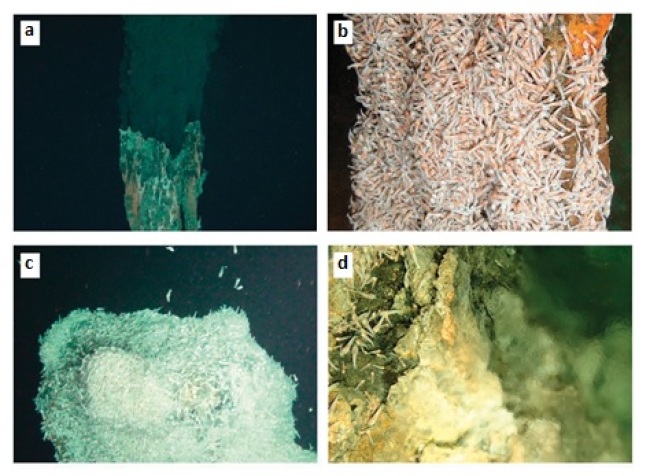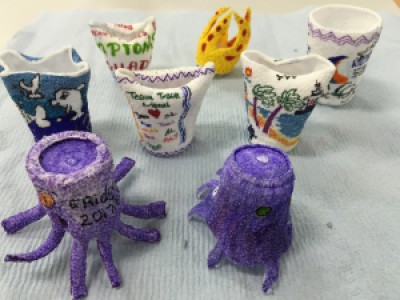How far are we from the deep ocean?
Human beings have held two dreams for long: to jump out of the world and to dive into the deep. Decades of exploration has gradually turned the brilliant dreams into reality. In the year 1960, the deepest part of the ocean – Mariana Trench (deeper than 10000 meters), was visited by two oceanographers. This marked the milestone demonstrating our capability to reach wherever we would like to reach in the ocean. However, as yet, we still cannot fully understand the physical, chemical, biological and geological features of the deep ocean. This in turn motivates our ambitions to figure out the deep mysteries that we’d like to know or we didn’t expect to know.
Lt. Don Walsh and Jacques Piccard in the bathyscaphe Trieste, making the first descent to the Challenger Deep in 1960. Image credit: Steve Nicklas, NOAA Ship Collection.
What I wanted to tell first is that the deep ocean is never an isolated system. During the MOOC course you’ve explored the large-scale thermohaline circulation wherein the denser and colder deep seawater plays a vital role. If something goes wrong in this loop, such as unusual melting of Greenland ice sheet with excessive production of fresh water – you know this has happened in the geological past, the global circulation as well as the heat transport could be disrupted. Subsequently such disruption would cause changes to the whole climate system in the world. Increased in-situ observations for the thermohaline circulation as well as improved numerical modelling thanks to super computers are now undertaken by researchers, aiming to clarify the physical mechanisms behind and to provide predictability for the climate.

Circulation patterns in the North Atlantic Ocean. Cold, dense seawater is shown in blue, flowing south from high latitudes, while warm and less dense water is shown in red, flowing north from low latitudes. Image credit: Jack Cook, for Ocean and Climate Change Institute, Woods Hole Oceanographic Institution.
You may also be surprised by a variety of hydrothermal vents that lie in the deep ocean, especially on mid-ocean ridges. The vent fluids emitted from seafloor generally contain extremely high concentrations of trace elements such as iron, manganese, copper, zinc… For a long time this source of trace elements to the oceans has been overlooked as people considered most of them would have been precipitated and settled down within the first few seconds of hydrothermal venting. However, up-to-date researches illustrate long distance transport of iron and some other trace elements away from the original vent fields into the ocean, which makes us have to reconsider what is going on between these ‘hot ports’ and the deep seawater. An interdisciplinary study is clearly required, and probably you’ve heard about the word ‘biogeochemistry’ which has become a very popular topic during the past 10 years and will continuously be focused on by people across the world, including me 🙂 All in all, it would be amazing if we can find hydrothermal sourced iron in intermediate and even shallow parts of the ocean, because this means the iron from the deep can possibly fuel the primary productivity in the surface, which will ultimately have an impact on the global change that we care about.

Chimneys and fauna from the Mid-Cayman Spreading Centre. (a) High-temperature venting at the Beebe vent field, depth 4960 m. (b) Aggregation of alvinocaridid shrimp on an active chimney at the Beebe vent field. (c) Peak of sulphide edifice at the Von Damm vent field, depth 2300 m, covered by aggregation of alvinocaridid shrimp. (d) Clear vent fluids and alvinocaridid shrimp at the Von Damm vent field. Image credit: Connelly, D. P. et al. Nat. Commun. 3:620 doi: 10.1038/ncomms1636 (2012).
These hydrothermal vents not only contribute chemical components to the oceans, but also serve as habitats for a diversity of biological activities. Please bear in mind that at the same time the vent fluids are enriched in sulfide and other reduced compounds (CH4 and H2), providing a source of chemical energy that can specially support life through chemosynthesis rather than photosynthesis. The bacterial community utilize such energy to generate organic matter (e.g. carbohydrate), supporting a high faunal biomass and providing nutrition for macroinvertebrates through symbiotic association. The figures above (taken from RRS JC44 cruise) just show the fantastic faunal observations from the Mid-Cayman Spreading Centre.
The adaption of eyes due to changes in lights was discussed in the course (week 3), and you also learnt that pressure is another variable that will affect life in the deep ocean. During a recent research cruise (RRS JC156) to the North Atlantic Ocean, we sent the polyethylene cups together with our water sample to as deep as 4000 meters – see what the cups looked like when they were back. Then you may realize how hard marine organisms protect themselves from being condensed. I would say, a promising approach for us to investigate the adaption mechanisms is to compare the genetic differences between life in deep sea and in shallow water.

Sending the cups down to 4000 meters – see what they look like when they are back!
The deep ocean is tightly associated with our daily life, but as many of you have pointed out, the exploitation of resources above or beneath the seafloor should be done with dual caution. It is necessary to assess any potential risks rising from what human beings interact with the blue planet, for example, the action of sub-seabed CO2 storage. It would be amazing if the capture of CO2 from the atmosphere and the stabilization into the ocean sediments work well, as this marks we are able to ‘moderate’ the climate given the global warming is driven by increased CO2 level. However, what if the CO2 storage site leaks? What’s the potential influence on benthic organisms and marine ecosystem? We need to answer these questions. Hopefully, a group of scientists are working together to develop comprehensive monitoring strategies and to set up guidelines for the best environmental practices. In addition, the National Oceanography Centre and the University of Southampton have collaborated for years in improving autonomy and generating advances in marine robotics (e.g. autonomous underwater vehicle, know as AUV), which technically enhances out confidences in addressing the questions above.

Autosub 6000, one of the National Oceanography Centre’s AUVs. Image credit: Doug Connelly, http://www.stemm-ccs.eu.
There is still a long way to go, but we are on the way getting our dreams approached!

